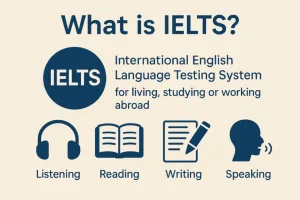Let’s face it: IELTS Speaking Part 2 is where many candidates feel the pressure building. Unlike Part 1’s friendly Q&A format, here you’re handed a cue card, a pencil, and just one minute to prepare. Then it’s showtime—you’re expected to speak for up to two minutes without interruption. Sounds intense? It can be. But with the right mindset and preparation, you can turn this moment into your opportunity to shine.
What Exactly Is Speaking Part 2?
This part of the exam is often called the “long turn.” The examiner gives you a task card with a topic and a few bullet points. You have one minute to take notes and prepare, then you’re expected to speak continuously for 1–2 minutes. The goal? Show your ability to organize your thoughts, use a wide range of vocabulary, and speak fluently under pressure.
Why It’s So Challenging (And That’s Okay)
Speaking for two minutes straight without a script can be intimidating. Your brain is racing, your mouth is dry, and you’re trying not to lose your train of thought. But here’s the good news: you don’t have to be perfect. The examiner is not looking for a flawless TED Talk. They want to see how well you can communicate an idea clearly and naturally.
Use the One-Minute Prep Time Like a Pro
That single minute before you speak is golden. Don’t waste it trying to write full sentences. Instead, jot down 4–5 keywords for each bullet point on the card. These are just mental anchors to help keep your speech flowing. Remember: the examiner won’t look at your notes, and neither should you rely on them too heavily while speaking.
The Secret Structure That Helps Everything Flow
Here’s a simple format that saved me during practice and the actual test: Introduction → Main Story → Details → Reflection. Start by briefly introducing the topic (“I’d like to talk about a time I…”), then tell your story or description, sprinkle in specific details, and finally wrap it up with a personal takeaway or lesson learned. It’s not just about answering the bullets—it’s about creating a narrative.
Train Your Brain with a Timer
Fluency is all about rhythm and pacing. I practiced by setting a 1-minute prep timer and then a 2-minute speaking timer. At first, I barely lasted 45 seconds. But with consistent practice, I could hit the two-minute mark without running out of things to say. This kind of targeted training builds stamina and confidence.
Be Descriptive—But Keep It Real
Details make your response vivid. Instead of saying, “I went to a restaurant,” say, “I went to a cozy little Italian place tucked in a quiet alley downtown.” But don’t overdo it. If it sounds fake or overly memorized, the examiner will notice. Speak the way you’d explain something to a friend.
Stuck? Buy Time With Smart Fillers
Everyone has moments when their mind goes blank. That’s okay. Learn to use natural-sounding fillers like, “Let me think for a second,” or “What I really liked about it was…” These give you a few extra seconds to regroup without awkward silence. Avoid robotic phrases like “According to my knowledge,” which can sound forced.

Don’t Memorize Answers—Memorize Patterns
It’s tempting to memorize sample answers, but IELTS examiners are trained to spot rehearsed speeches. Instead, memorize structures and sentence patterns. For example: “There was this one time when…,” “What made it unforgettable was…,” “It all started when…” These give your speech a natural rhythm while keeping you adaptable.
Record Yourself—and Be Brutally Honest
One of the most effective ways to improve is recording your responses and listening back. Notice your filler words, pacing, and pronunciation. Are you hesitating too much? Are you using the same word over and over? This kind of self-feedback helps you improve faster than just practicing in your head.
Include Feelings and Reflections
The examiner wants to hear how the event or experience affected you. Don’t just describe what happened—talk about how you felt. “I was really nervous at first, but then…” or “It was a moment I’ll never forget because…” Emotion adds depth and personality to your answer.
Use Connectors to Sound Fluent
To avoid sounding choppy, link your ideas with natural connectors: “First of all…,” “Then…,” “After that…,” “Finally…,” “Looking back…” This helps your speech feel like a story rather than a list of facts. These transitions also give you tiny mental breaks while sounding polished.
Don’t Panic if You Finish Early
If you wrap up your talk before the two minutes are over, try to expand on a detail or add a reflection. For example: “Another thing that stands out in my memory is…” or “If I had the chance, I’d definitely do it again.” But if you really can’t add anything more, just smile confidently—the examiner may still be satisfied with what you’ve said.
The Test Day Mindset
On the actual day, remember: you’ve trained for this. You know the structure. You’ve practiced the timing. Take a deep breath, speak clearly, and imagine you’re telling a story to someone genuinely curious. The examiner is not there to trap you—they want you to succeed.
Final Thoughts: From Fear to Flow
IELTS Speaking Part 2 doesn’t have to be your nightmare. With structured practice, the right mental strategies, and a focus on natural storytelling, it can become your strength. Don’t aim for perfection—aim for connection. When you speak from experience and use clear, expressive language, the two minutes will fly by. And you just might enjoy it.



